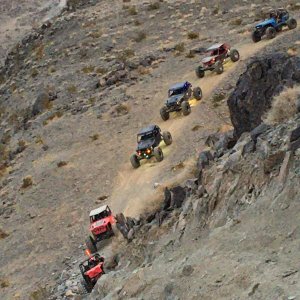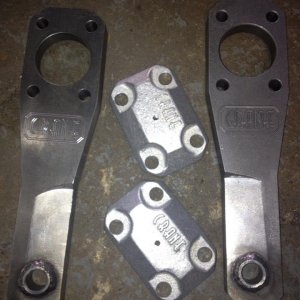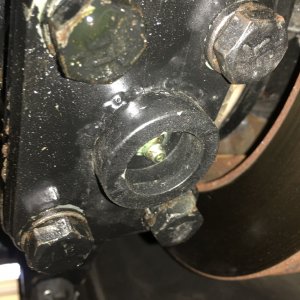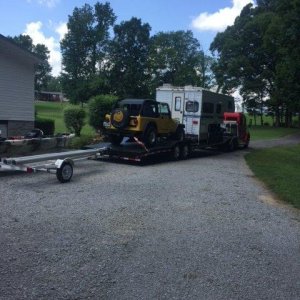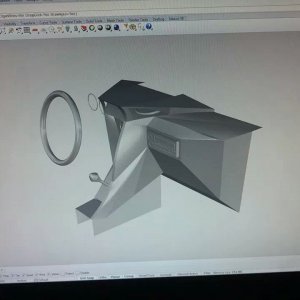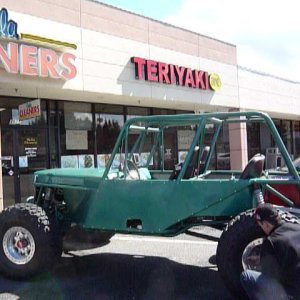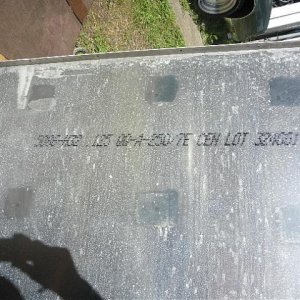KarlVP
Love that TOYOTA
Recreation
Peeling Out, With Impunity
Now people who rip up the earth have their own parks; a Hummer spitting gravel
By CONOR DOUGHERTY
December 2, 2006; Page P1
GILBERT, Minn. -- Several weeks ago, Dan Olson took a drive in the woods, revving his blue Chevy Blazer through mud banks and over piles of boulders, coughing up plumes of smoke that smelled like a freeway accident.
In most towns, that would get you arrested. But Mr. Olson had traveled 4½ hours to an off-road park here that caters to all-terrain vehicle, Jeep and dirt-bike owners looking to tear around nature without fear of a trespassing ticket. "It's a lot of fun," says the mechanic from Colfax, Wis.
 Area BFE in Moab, UtahThere's a new refuge for people whose hobbies run on the wrong side of public opinion: parks -- often on private property -- where guys (it's mostly men, but wives and girlfriends often come along for the ride) can rip up the earth without fear of the enviro cops. Over the last decade, the federal government and a number of states have banned off-roading from millions of acres of public land. Yet these vehicles are increasingly popular -- sales of ATVs over the past 10 years have almost tripled. That gap has created a business opportunity for entrepreneurs and local governments.
Area BFE in Moab, UtahThere's a new refuge for people whose hobbies run on the wrong side of public opinion: parks -- often on private property -- where guys (it's mostly men, but wives and girlfriends often come along for the ride) can rip up the earth without fear of the enviro cops. Over the last decade, the federal government and a number of states have banned off-roading from millions of acres of public land. Yet these vehicles are increasingly popular -- sales of ATVs over the past 10 years have almost tripled. That gap has created a business opportunity for entrepreneurs and local governments.
The parks -- there are now dozens, from South Carolina to Utah -- are gaining traction just as the off-road industry is rolling out a new generation of tricked-out vehicles: from buggies that climb up 80-degree inclines to the Quadski, a jet ski that converts into an ATV on land. The Rough Terrain Vehicle, a $30,000 buggy-like contraption from Rhino Off-Road Industries, has waist-high tires and roll bars across the roof. "Think of it as the child of a monster truck and an ATV," says Howard Pearl, Rhino's president.
Many of the off-road parks set up picnic tables and Port-o-Potties along the trails, which have names like "Axle Trap" and "Undertaker." Some offer ramps for trucks to attempt 50-foot leaps -- one park owner calls them "Dukes of Hazzard" jumps -- while others tout mogul runs of six-foot-high dirt piles and open fields for spinning donuts. At Iron Range Off-Highway Vehicle Recreation Area, the abandoned ore-mine-turned-offroad-park in Gilbert, a number of ATVers use "snorkels," or plastic extensions that allow vehicles to operate under water. The devices are banned on public lands in the state because submerged ATVs can pollute streams. Dave Schotzko, assistant manager of Iron Range, says that's not an issue at his park: "You can't really harm a gravel pit," he says.
The nation's off-roaders still spend most of their time on public forest and desert lands. But designated parks are increasingly an option, particularly for off-roaders in urban centers. Whether the parks are owned by private individuals or purchased by state and local governments to attract tourists, the goal is the same: to give off-roaders a place where they can escape the complaints about noise pollution, tire tracks and frightened animals.
In West Virginia, the government runs the Hatfield-McCoy trail system, a 500-mile network stitched together on land owned mostly by coal, timber and gas companies. Some 24,000 off-roaders used the park last year, compared with around 4,000 in 2001. In South Carolina, a pair of entrepreneurs have sunk $8 million into Carolina Adventure World, which is set to open early next year with cabins and a handful of yurts. Then there's Jeremy Parriott. The dirt biker and several partners paid around $1 million for 320 acres in the Utah desert, renamed it "Area BFE," and now let bikers and off-roaders ride free.
 Iron Range Off-Highway Vehicle Recreation Area in Gilbert, Minn.For off-roaders, crackups are part of the thrill. At Iron Range, the same weekend Mr. Olson was tooling around, another Chevy Blazer tried to navigate a steep incline of mud, and tumbled down sideways, caving in the roof and ripping off a tire. A Hummer got stuck halfway up another long hill, its tires spitting gravel, and had to be bailed out with a winch.
Iron Range Off-Highway Vehicle Recreation Area in Gilbert, Minn.For off-roaders, crackups are part of the thrill. At Iron Range, the same weekend Mr. Olson was tooling around, another Chevy Blazer tried to navigate a steep incline of mud, and tumbled down sideways, caving in the roof and ripping off a tire. A Hummer got stuck halfway up another long hill, its tires spitting gravel, and had to be bailed out with a winch.
The parks, though a popular outlet among off-roaders, aren't universally embraced. While the sales of former timber farms and other big plots provide an opportunity for well-heeled off-roaders to set up a ATV park -- they also provide an opening for conservation groups eager to rid those areas of "consumptive uses" like hunting and motorized recreation.
While the park in Gilbert was proposed in the mid-1990s -- at the time, the land was a popular spot to (illegally) dump old couches and refrigerators -- it took several years to realize. That's because of noise complaints, a lawsuit and the discovery of a rare fern on the stripped iron land.
It took Richard Mull four years to open his off-road park, Brushy Mountain Motorsports Park in Taylorsville, N.C. The first time Mr. Mull, a real-estate developer, tried to buy and rezone land, his plans prompted a big enough backlash, including threats of sabotage if the park were opened, that he abandoned the project without a fight. "We basically walked away from a year's time and $25,000 and started again," he says.
The off-road community argues that dedicated parks minimize the environmental harm. Trailpass, a network of private trails mainly in the Eastern U.S., says that its 1,000-plus miles of trails are built with bridges, to keep riders out of natural creeks, and switchbacks that counter erosion. Mr. Mull says he won't let in tires with more than a 3/4-inch tread because they rip up his trails, which he then has to pay to repair.
The off-road park clientele ranges from kids to retirees, and the trails are set up to appeal to novices as well as thrill seekers. The parks have borrowed the ski industry's green-blue-black nomenclature to rate the difficulty level of trails.
PLAYING DIRTY
A snapshot of some of the off-road parks that are popping up.
NAME PRICE DISTINGUISHING FEATURE COMMENT Area BFE
Moab, Utah Free Ramps are set up for a 50-foot leap -- the owner calls it the "Dukes of Hazzard" jump This park, on a uranium deposit in the Utah desert, is one of the more extreme in the country; among other tricks, it has metal railings that cars jump onto and slide down Hatfield-McCoy
Lyburn, W.Va. $19/day ATV riders can hit a McDonald's drive-through because the trail system runs through some small towns Among the country's largest off-roading networks, with 500 miles of trails spread over four counties in southern West Virginia Durhamtown Plantation
Union Point, Ga. $25/day ATVers have to share the park with hunters, anglers and skateboarders The 8,000 acres are deep with history, from remnants of moonshine stills to a cemetery that holds plantation families and slaves Paragon Adventure Park
Hazleton, Pa. $25 to $35 Off-road classes ($500) teach truck owners how to wade through water -- and recover their truck when it gets stuck The park has everything from green trails ("Turtle Trail") to trails that can't be accessed without a park guide ("Death Valley")
ATVs have also come under fire for their safety record, especially when the riders are children. The Consumer Product Safety Commission estimated that in 2004, the latest data available, ATVs were the cause of 136,100 emergency-room-treated injuries, up 48% from 2000. Mike Mount, spokesman for the Specialty Vehicle Institute of America, the trade association for the ATV industry, says that because of the big increase in ATV usage, the injury rate has remained flat for the last couple of years. "We still want that number to go down," he says.
For towns like Gilbert, off-roading represents a chance to diversify an economy hit hard by the decline in mining jobs. The town's population has plummeted about 30% over the past two decades, to 1,800. The off-road park has spawned some new businesses in town. Fun Time Rental, which rents out ATVs and snowmobiles, runs out of stock most weekends. Across the street, Milt Lerfald, a laid-off miner, used savings and a bank loan to build a $500,000 car wash that caters to all the trucks and trailers that now pass through town.
But others are using their money to keep offroaders away. Roxanne Quimby, former CEO of cosmetics and candle company Burt's Bees, has spent just under $40 million since 2000 buying some 70,000 acres of forest land. She has shut down dozens of miles of ATV and snowmobile trails. For riders that ignore the new mandates, Ms. Quimby has erected gates, destroyed bridges and culverts that patch together trails, and laid boulders across access roads. "It's bad news for them when I buy a piece of property," says Ms. Quimby.
__________________
Peeling Out, With Impunity
Now people who rip up the earth have their own parks; a Hummer spitting gravel
By CONOR DOUGHERTY
December 2, 2006; Page P1
GILBERT, Minn. -- Several weeks ago, Dan Olson took a drive in the woods, revving his blue Chevy Blazer through mud banks and over piles of boulders, coughing up plumes of smoke that smelled like a freeway accident.
In most towns, that would get you arrested. But Mr. Olson had traveled 4½ hours to an off-road park here that caters to all-terrain vehicle, Jeep and dirt-bike owners looking to tear around nature without fear of a trespassing ticket. "It's a lot of fun," says the mechanic from Colfax, Wis.

The parks -- there are now dozens, from South Carolina to Utah -- are gaining traction just as the off-road industry is rolling out a new generation of tricked-out vehicles: from buggies that climb up 80-degree inclines to the Quadski, a jet ski that converts into an ATV on land. The Rough Terrain Vehicle, a $30,000 buggy-like contraption from Rhino Off-Road Industries, has waist-high tires and roll bars across the roof. "Think of it as the child of a monster truck and an ATV," says Howard Pearl, Rhino's president.
Many of the off-road parks set up picnic tables and Port-o-Potties along the trails, which have names like "Axle Trap" and "Undertaker." Some offer ramps for trucks to attempt 50-foot leaps -- one park owner calls them "Dukes of Hazzard" jumps -- while others tout mogul runs of six-foot-high dirt piles and open fields for spinning donuts. At Iron Range Off-Highway Vehicle Recreation Area, the abandoned ore-mine-turned-offroad-park in Gilbert, a number of ATVers use "snorkels," or plastic extensions that allow vehicles to operate under water. The devices are banned on public lands in the state because submerged ATVs can pollute streams. Dave Schotzko, assistant manager of Iron Range, says that's not an issue at his park: "You can't really harm a gravel pit," he says.
The nation's off-roaders still spend most of their time on public forest and desert lands. But designated parks are increasingly an option, particularly for off-roaders in urban centers. Whether the parks are owned by private individuals or purchased by state and local governments to attract tourists, the goal is the same: to give off-roaders a place where they can escape the complaints about noise pollution, tire tracks and frightened animals.
In West Virginia, the government runs the Hatfield-McCoy trail system, a 500-mile network stitched together on land owned mostly by coal, timber and gas companies. Some 24,000 off-roaders used the park last year, compared with around 4,000 in 2001. In South Carolina, a pair of entrepreneurs have sunk $8 million into Carolina Adventure World, which is set to open early next year with cabins and a handful of yurts. Then there's Jeremy Parriott. The dirt biker and several partners paid around $1 million for 320 acres in the Utah desert, renamed it "Area BFE," and now let bikers and off-roaders ride free.

The parks, though a popular outlet among off-roaders, aren't universally embraced. While the sales of former timber farms and other big plots provide an opportunity for well-heeled off-roaders to set up a ATV park -- they also provide an opening for conservation groups eager to rid those areas of "consumptive uses" like hunting and motorized recreation.
While the park in Gilbert was proposed in the mid-1990s -- at the time, the land was a popular spot to (illegally) dump old couches and refrigerators -- it took several years to realize. That's because of noise complaints, a lawsuit and the discovery of a rare fern on the stripped iron land.
It took Richard Mull four years to open his off-road park, Brushy Mountain Motorsports Park in Taylorsville, N.C. The first time Mr. Mull, a real-estate developer, tried to buy and rezone land, his plans prompted a big enough backlash, including threats of sabotage if the park were opened, that he abandoned the project without a fight. "We basically walked away from a year's time and $25,000 and started again," he says.
The off-road community argues that dedicated parks minimize the environmental harm. Trailpass, a network of private trails mainly in the Eastern U.S., says that its 1,000-plus miles of trails are built with bridges, to keep riders out of natural creeks, and switchbacks that counter erosion. Mr. Mull says he won't let in tires with more than a 3/4-inch tread because they rip up his trails, which he then has to pay to repair.
The off-road park clientele ranges from kids to retirees, and the trails are set up to appeal to novices as well as thrill seekers. The parks have borrowed the ski industry's green-blue-black nomenclature to rate the difficulty level of trails.
PLAYING DIRTY
A snapshot of some of the off-road parks that are popping up.
NAME PRICE DISTINGUISHING FEATURE COMMENT Area BFE
Moab, Utah Free Ramps are set up for a 50-foot leap -- the owner calls it the "Dukes of Hazzard" jump This park, on a uranium deposit in the Utah desert, is one of the more extreme in the country; among other tricks, it has metal railings that cars jump onto and slide down Hatfield-McCoy
Lyburn, W.Va. $19/day ATV riders can hit a McDonald's drive-through because the trail system runs through some small towns Among the country's largest off-roading networks, with 500 miles of trails spread over four counties in southern West Virginia Durhamtown Plantation
Union Point, Ga. $25/day ATVers have to share the park with hunters, anglers and skateboarders The 8,000 acres are deep with history, from remnants of moonshine stills to a cemetery that holds plantation families and slaves Paragon Adventure Park
Hazleton, Pa. $25 to $35 Off-road classes ($500) teach truck owners how to wade through water -- and recover their truck when it gets stuck The park has everything from green trails ("Turtle Trail") to trails that can't be accessed without a park guide ("Death Valley")
ATVs have also come under fire for their safety record, especially when the riders are children. The Consumer Product Safety Commission estimated that in 2004, the latest data available, ATVs were the cause of 136,100 emergency-room-treated injuries, up 48% from 2000. Mike Mount, spokesman for the Specialty Vehicle Institute of America, the trade association for the ATV industry, says that because of the big increase in ATV usage, the injury rate has remained flat for the last couple of years. "We still want that number to go down," he says.
For towns like Gilbert, off-roading represents a chance to diversify an economy hit hard by the decline in mining jobs. The town's population has plummeted about 30% over the past two decades, to 1,800. The off-road park has spawned some new businesses in town. Fun Time Rental, which rents out ATVs and snowmobiles, runs out of stock most weekends. Across the street, Milt Lerfald, a laid-off miner, used savings and a bank loan to build a $500,000 car wash that caters to all the trucks and trailers that now pass through town.
But others are using their money to keep offroaders away. Roxanne Quimby, former CEO of cosmetics and candle company Burt's Bees, has spent just under $40 million since 2000 buying some 70,000 acres of forest land. She has shut down dozens of miles of ATV and snowmobile trails. For riders that ignore the new mandates, Ms. Quimby has erected gates, destroyed bridges and culverts that patch together trails, and laid boulders across access roads. "It's bad news for them when I buy a piece of property," says Ms. Quimby.
__________________

